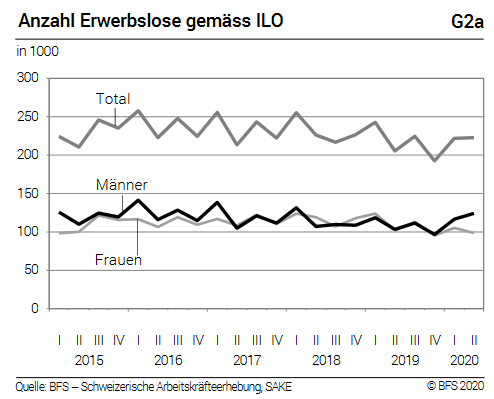| 08/20/2020 – The number of people in employment in Switzerland fell by 1.6% between the 2nd quarter of 2019 and the 2nd quarter of 2020 (–82,000). In addition, the actual weekly working hours per employed person fell by 9.5%. In the same period, the unemployment rate as defined by the International Labor Office (ILO) rose from 4.2% to 4.6% in Switzerland and from 6.6% to 6.9% in the EU. This is the result of the Swiss Labor Force Survey (SLFS).
In Switzerland, a total of 5.017 million people were employed in the 2nd quarter of 2020, 1.6% fewer than in the 2nd quarter of 2019 (5.099 million; people with short-time work are considered to be employed). This is the first time since 1993 that the number of people in employment has fallen so sharply. The number of employed men fell by 1.5% and that of employed women by 1.7%. In full-time equivalents (FTE), the decrease compared to the corresponding quarter of the previous year was minus 1.2% (men: –0.4%; women: –2.4%). Seasonally adjusted, the number of persons in employment and the number of FTEs fell by –2.5% and –2.2%, respectively, between the 1st quarter of 2020 and the 2nd quarter of 2020. |
Unemployed According to ILO, Q1 2015-Q2 2020 - Click to enlarge |
Swiss and foreign workers
Between the 2nd quarter of 2019 and the 2nd quarter of 2020, the number of Swiss employed persons decreased by –2.4% and that of the foreign employed increased by 0.2%. The development of foreign workers varies depending on the residence status. The number of employed persons with a short-term residence permit (L permit, for less than twelve months in Switzerland; –16.2%) fell most significantly. There was a decrease of –3.6% for people with a residence permit (permit B or L, for at least twelve months in Switzerland). On the other hand, there was an increase for people with a permanent residence permit (permit C: + 2.3%) and for cross-border commuters (permit G: + 3.6%). In the latter, part of this increase is due to a technical effect (see methodological appendix).
Unemployment in Switzerland and Europe
In the second quarter of 2020, 223,000 people were unemployed in Switzerland according to the definition of the ILO. That is 17,000 more than a year earlier. The share of unemployed in the labor force was 4.6% and thus higher than in the corresponding quarter of the previous year (4.2%). Seasonally adjusted, the unemployment rate increased by 0.5 percentage points from 4.2% to 4.8% compared to the previous quarter. Between the 2nd quarter of 2019 and the 2nd quarter of 2020, the unemployment rate rose both in the European Union (EU: from 6.6% to 6.9%) and in the euro zone (EZ19: from 7.4% to 7, 6%).
Youth unemployment
In Switzerland, the youth unemployment rate (15 to 24-year-olds) rose from 6.2% to 8.4% between the 2nd quarter of 2019 and the 2nd quarter of 2020 according to the ILO. During the same period, the youth unemployment rate increased both in the European Union (EU: from 14.9% to 16.4%) and in the euro zone (EZ19: from 15.4% to 16.7%).
Unemployment according to various characteristics
The unemployment rate rose from 3.9% to 4.8% for men, while it remained stable at 4.4% for women. It increased sharply for people without post-compulsory education (from 6.7% to 8.6%), for people with an upper secondary level a little less from 4.4% to 4.8% and for people with a tertiary level qualification it remained unchanged at 3.1%. During the same period, the unemployment rate among Swiss people rose from 3.0% to 3.4% and among foreigners from 7.3% to 7.6%. In the 2nd quarter of 2020, the unemployment rate according to ILO for EU / EFTA / UK nationals was 6.3% and for nationals from third countries was 10.9%.
More inactive people who would be available but not actively looking for work
Of the 2.4 million inactive people, 225,000 were available for a job in Q2 2020, but not looking for a job. According to the ILO definition, these people are not considered to be unemployed. Compared to the 2nd quarter of 2019, this group has grown very strongly (+56,000 people, or + 32.8%), which among other things explains the considerable decline in the number of people in employment with a rather moderate increase in the number of unemployed.
Estimated impact of the Covid-19 pandemic on working hours
The measures to protect the population were extended until May 11, 2020, after which activities were gradually resumed. In the 2nd quarter of 2020, the actual weekly working hours per employed person therefore fell by 9.5% compared to the same quarter of the previous year. This decline was more pronounced among the self-employed (–13.9%) than among employees (–9.1%). If the average number of vacation days had not fallen by half during this period (–52.6%), the decrease in actual weekly working hours would have been even higher.
The FSO will publish more detailed analyzes of the labor market in connection with the pandemic in September 2020. |
Unemployment Rate and Youth Unemployment Rate, Q2 2020 - Click to enlarge |
































